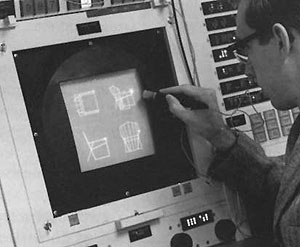Information Spaces, Referat im Seminar "Next Generation Interfaces" ; Ralf Bähren, Mai 2003
SKETCHPAD (1963)
Ivan E. Sutherland, MIT


Verwandte Themen:
ABSTRACT: Das Sketchpad war zur Zeit seiner Entstehung das erste
computergesteuerte Zeichengerät
und somit die Grundlage Interaktiver Computergraphik.
The display, a lightpen, and a bank of switches were the interface on which Ivan based the first interactive computer graphics. In 1963, his Ph.D. thesis, "Sketchpad: A Man-machine Graphical Communications System," used the lightpen to create engineering drawings directly on the CRT.
Highly precise drawings could be created, manipulated, duplicated, and stored. The software provided a scale of 2000:1, offering many acres of drawing space.
Sketchpad pioneered the concepts of graphical computing, including memory structures to store objects, rubber-banding of lines, the ability to zoom in and out on the display, and the ability to make perfect lines, corners, and joints.
Features:
popup menus
constraint-based drawing
hierarchical modelling
This real-time manipulation of graphics by Sketchpad and the TX-2 computer became the foundation for Computer-Aided Design (CAD) and was the first Graphical User Interface (GUI).
Externe Links: